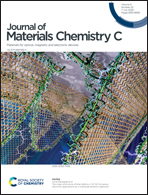Conductive, self-healable and reusable poly(3,4-ethylenedioxythiophene)-based hydrogels for highly sensitive pressure arrays†
Abstract
Although challenging, the preparation of pure conducting polymer (CP) hydrogels as conductive flexible networks for developing high-performance functional platforms is an outstanding alternative to conventional approaches, as for example those based on the cross-linking of insulating polymers with CP segments and the simple utilization of CPs as fillers of insulating hydrogel networks. In this work, we propose the employment of poly(3,4-ethylenedioxythiophene):poly(styrenesulfonate) (PEDOT:PSS) to prepare conductive hydrogels by partially replacing the PSS dopant by alginate (Alg) chains, which is energetically favoured. The capacity of Alg chains to be electrostatically cross-linked by Ca2+ ions has allowed us to obtain hydrogels with good electrical percolation response and mechanical properties. Hydrogels were prepared in a very simple one-step process by adding CaCl2 to different mixtures of PEDOT : PSS and alginic acid (1 : 3, 1 : 1 and 3 : 1). After structural, chemical and physical characterization, the 1 : 3 PEDOT/Alg hydrogel was moulded to fabricate stretchable touch-pressure sensor arrays, which exhibited fast response and good spatial resolution of the pressure distribution. In addition, the PEDOT/Alg hydrogel is self-healable which allowed us to prepare reusable pressure sensors (i.e. devices that can be reprocessed to be used in their original application) thanks to the reversibility of the noncovalent Ca2+ crosslinks. Reusable devices are different to reclaimed and recycled devices as these are no longer used for the same application because the materials lose their properties. With our hydrogels we are a step closer to a circular economy by allowing the reuse of electronic devices and reducing electronic waste worldwide. Moreover, the superior performance of the PEDOT/Alg hydrogel opens up its utilization as an efficient and flexible pressure sensor for wearable human-electronic interfaces, in which reusability would be an added value.



 Please wait while we load your content...
Please wait while we load your content...